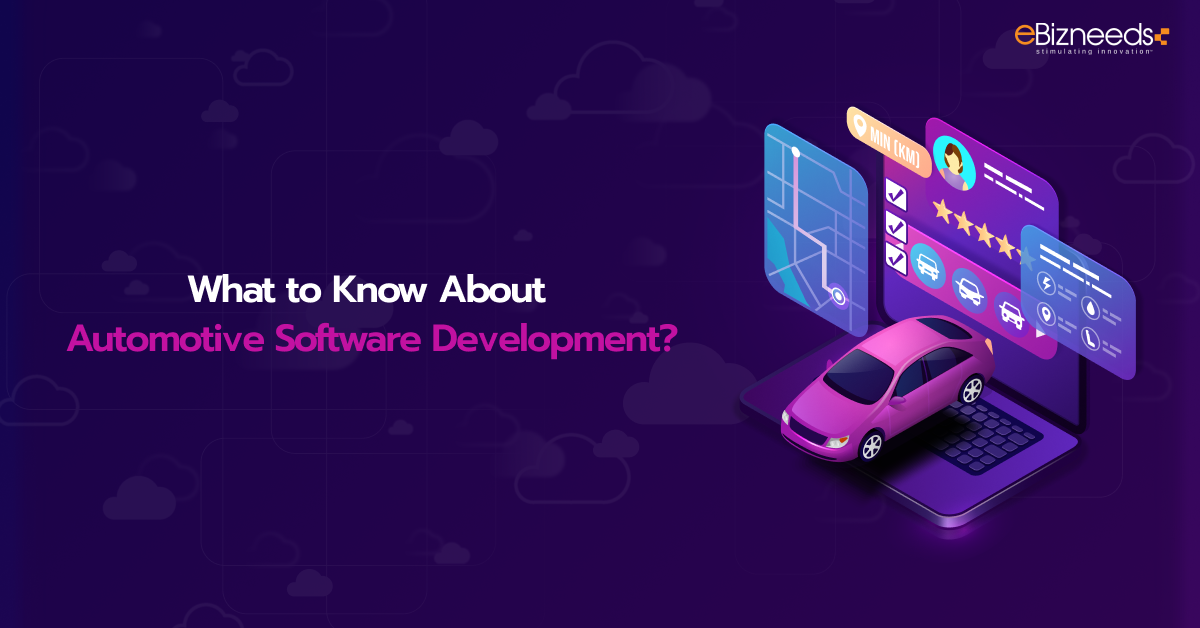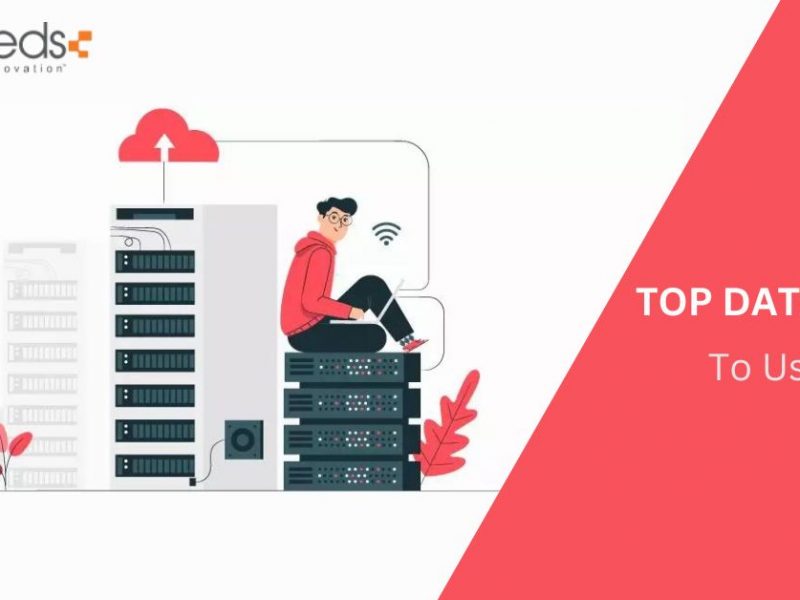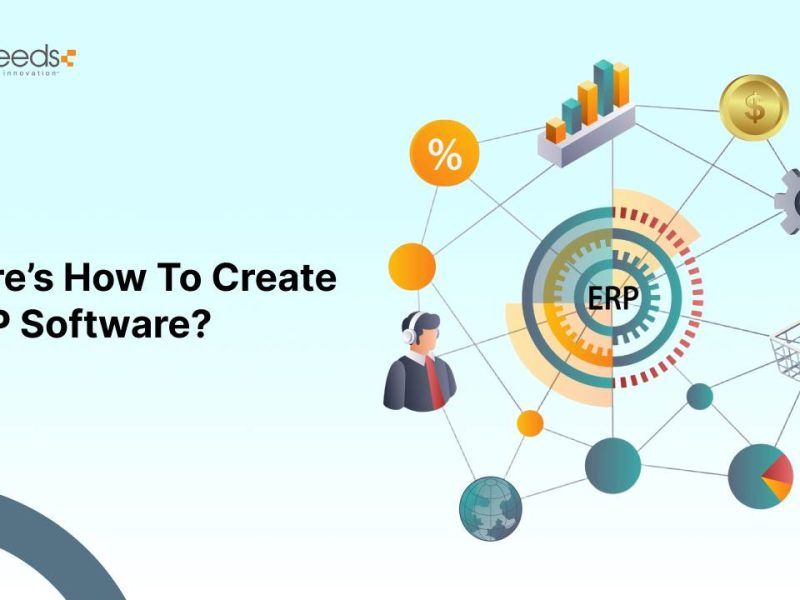In Today’s digital era, the automotive industry is growing fast. Cars are just no longer about power and appearance. From advanced driver assistance to user-friendly infotainment, software is transforming how we drive and interact with our cars. The automotive industry is all about how manufacturers design and build them. As per the McKinsey report, the global market for automotive software and electronics is expected to raise $462 billion by 2030. The market is growing at a rate of 5.5% per year from 2019 to 2030. Here is a comprehensive guide to automotive software development in 2024, covering all the essential points.
The growth considers different factors such as stricter regulations on gas-powered vehicles. It’s a move towards car-sharing and the adoption of micro-mobility solutions like scooters, and advancement in autonomous driving technologies. As the industry evolves, software and electronics are not only crucial components of modern vehicles but also drive innovation.
With the shift towards software-focused automotive design, there is a variety of automotive software being created. This includes an infotainment system for connectivity and entertainment and advanced engine management systems that improve performance and efficiency as well.
The boom in automotive software brings lots of opportunities for large and small businesses. However, understanding the costs and features of the automotive software development industry can be tough. This guide will help you to understand the key functionality in modern vehicles and what affects their development costs.
What are the Popular Types of Automotive Software?
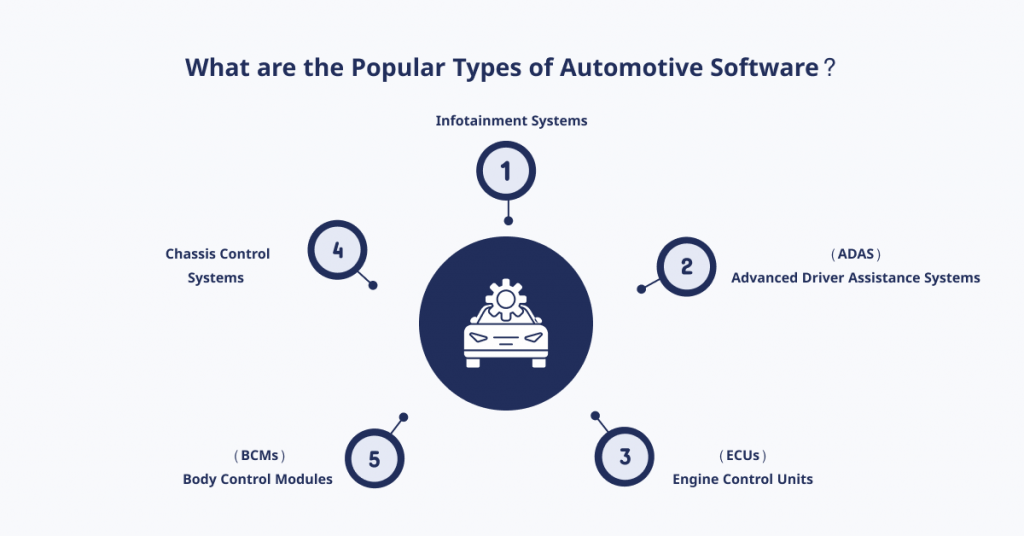


Automotive software systems handle everything from simple design control to complex tasks such as autonomous driving. This software powers basic operations like engine management and advanced functions for self-driving technologies. This system can efficiently manage internal mechanics and electronics while increasing user experience with advanced infotainment and connectivity solutions. Automotive software is of many types. Let’s explore some of the main types:-
1. Advanced Driver Assistance Systems (ADAS)
Advanced Driver Assistance Systems (ADAS) is specially designed to ensure the safety of drivers and passengers through sensors and other technology while driving. These systems are now standard in the automotive industry and are used for making roads safer. The vital features of ADAS are lane-keeping assistance, collision warnings, adaptive speed control, and cross-traffic alerts. All these also help reduce accidents and increase the safety of vehicles.
2. Engine Control Units (ECUs)
Engine Control Units (ECUs) keep an eye on the performance and efficiency of the engine. EUCs control functions like ignition timing, emission control, and fuel injection. These are essential for maintaining optimal engine performance, enhancing fuel efficiency, and reducing emissions.
3. Infotainment Systems
Infotainment Systems handles a vehicle’s multimedia and entertainment functions. These often include video, audio, navigation, and connectivity such as Wi-Fi and Bluetooth. The main motive is to offer passengers an enjoyable and easy-to-use experience while smoothly integrating with another vehicle system.
4. Body Control Modules (BCMs)
Body Control Modules (BCMs) are popular for controlling various vehicle functions such as wipers, lighting, and door locks. They also work with other systems to ensure a smooth, safe, and flawless driving experience. BCMs are essential for maintaining the vehicle’s proper operation and reliability
5. Chassis Control Systems
Chassis Control Systems handles a vehicle’s steering, suspension, and brakes. They work together to ensure a smooth and stable ride, better handling, and improved overall performance
Autonomous and Autonomous-Ready Systems
Autonomous and Autonomous-Ready Systems enable vehicles to drive on their own and with minimal driver assistance. The software uses advanced sensors, cameras, and software to sense and react to the surroundings. There are many supporting features available such as semi-autonomous driving, automatic emergency braking, and lane cantering. These systems are key to creating self-driving cars and are set to convert the auto industry.
These systems often overlap and work together to ensure modern vehicles are safe, efficient, and reliable while driving.
Essential Features of Cutting-Edge Automotive Software
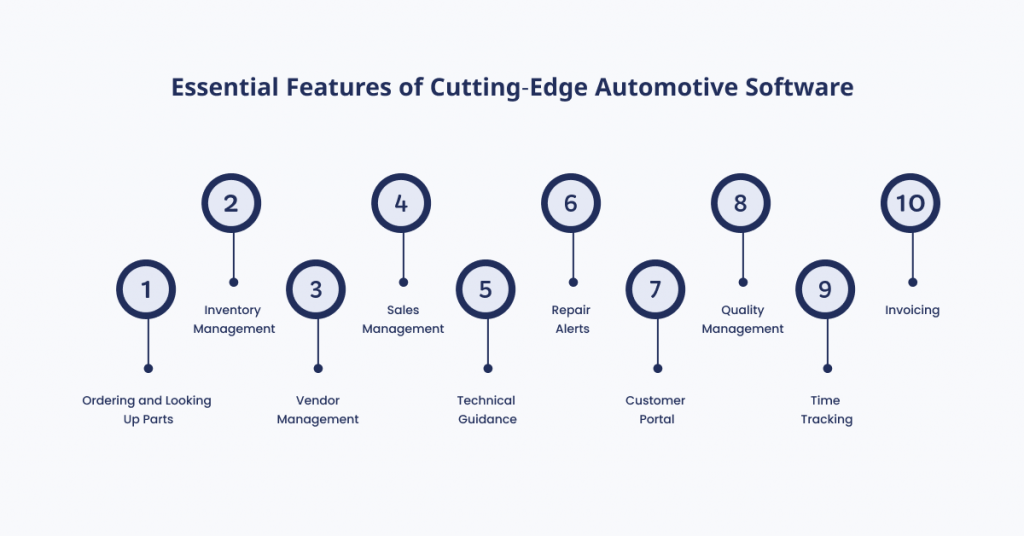


However, it becomes essential to include key features to develop reliable and effective automotive software that helps automate processes, increase user satisfaction, and boost productivity.
While the features may vary depending on the specific type of software. Here are some fundamental features usually merged into most automotive software solutions. Have a look at these key features for automotive software development.
Ordering and Looking Up Parts
This feature helps to find and order automotive parts. Users can search a large database using details like part number, model, make, or vehicle year. This offers accurate information on part availability and compatibility and also reduces order errors. Moreover, this feature also involves automated ordering, order tracking, and timely updates that help to improve efficiency for automotive businesses.
Inventory Management
Controlling the dealership inventory plays a great role and software helps keep tracking parts and vehicles in real-time. Automated restocking helps to prevent shortages or excess. Also, it allows you to sort inventory by type, model, and condition to access it easily. It also predicts sales trends and inventory turnover and provides insights to optimize stock levels. Moreover, it also reduces costs and improves cash flow. This makes efficient inventory management essential for business growth and success.
Vendor Management
The vendor management module enables many businesses to handle multiple suppliers and service providers. It supports communication and coordination that’s what makes it easy to place and track orders. This feature stores and accesses vendor information, performance metrics, and pricing in one place. Businesses can assess vendor performance based on delivery times, product quality, and service reliability. This allows them to make informed decisions and negotiate better terms. Effective vendor management ensures a reliable supply chain, and improved vendor relationships and savings in cost.
Sales Management
Various sales management tools help car dealerships handle sales procedures and everything from bringing leads to closing deals. There are including many features like sales tracking, lead management, and customer relationship management (CRM). The software collects leads by using different sources. After that assigns them to sales reps and tracks their progress. The CRM has customer details, their preferences, and interactions that enable personalized communication and follow-ups. Sales tracking offers insights into performance and enables managers to set goals, define trends, and enhance sales tactics as well as planning. By following these processes, the dealership can enhance conversion rate let the customers have a flawless experience, and increase revenue.
Technical Guidance
The tool offers businesses with detailed repair instructions, and important technical data, enhancing diagnostic accuracy and repair efficiency. This includes easy guides, tips, service notes, and writing diagrams. This tool helps to reduce diagnosis time, ensures high-quality service, and increases repair precision.
Repair Alerts
These notifications monitor vehicles serviced by repair dealerships or shops OR Dealerships and alert clients when repair or maintenance is necessary. When the proper attention is required, the system uses the diagnostic data and service history. Customers receive timely reminders for tasks like tire rotations and oil changes. This proactive approach helps in vehicle maintenance and increases profits and customer loyalty. Also, encourages repeat business and offers additional services.
Customer Portal
The customer portal offers personalized information to car owners about their vehicles like upcoming maintenance schedules, repair status, and service records. Through this portal, customers can schedule appointments easily, examine invoices, and receive updates about the vehicle. This transparency and easy access provide a flawless experience to customers. Moreover, the portal can offer educational content like maintenance tips and guide customers on how to maintain their vehicles.
Quality Management
Quality management makes sure that the car parts and services meet safety and all the performance standards. It involves testing various components and systems to identify defects or issues so they can be fixed quickly. Quality management includes inspections, audits, and certifications to find problems early. Also, it reduces the likelihood of recalls and ensures customer satisfaction. Delivering high-quality products and services helps build trust and credibility with users.
Time Tracking
Tracking time is a crucial feature for viewing workflow and productivity in the automotive sector. It allows businesses to oversee how resources are utilized by recording the start and end times of tasks, breaks, and shift durations. This data highlights areas for efficiency improvement, ensures accurate billing for labor, and supports performance evaluations. The time-tracking data also helps managers allocate resources effectively and acknowledge top-performing staff. Optimizing time management in this way enhances overall operational efficiency and profitability.
Invoicing
The invoicing feature automates service bills, parts, and labor. Through this feature, the financial operation becomes more efficient. It can generate precise invoices, track payments and manage outstanding bills. Integration with accounting software makes financial management smooth and easy. If the invoice is generated automatically then it will reduce the errors, speed up billing, and enhance cash flow with timely payments. This feature offers various payment options to customers that improve their overall experience.
Key Steps in the Automotive Software Development Procedure
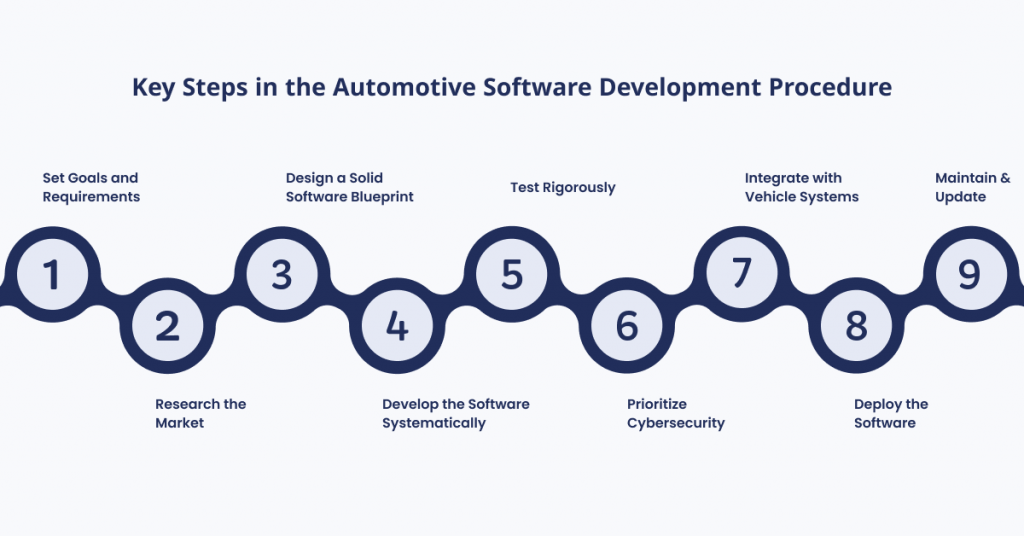


The demand for the Automotive is increasing day by day. Creating automotive software demands a careful and organized process to meet industry standards and user requirements. The process includes many stages from initial concept and design to development, testing, and deployment. All these steps are important to deliver a top-notch software solution. Let’s explore the custom automotive software development process from start to end.
Set Goals and Requirements
Firstly, start with identifying your goals and objectives for automotive software development. This involves stakeholders like, repair shops, car manufacturers, and end users to gather thorough insights into what they require and expect. Also, you should find out the necessary features of the automotive software you are planning to include. Make sure this meets safety standards such as ISO 26262 and architectural standards like AUTOSAR for safety.
Research the Market
The research part is also important for understanding your competitor’s strategies and their next move. Also, you should try to analyze user requirements and preferences. Businesses can examine the existing automotive software solutions to analyze strengths and weaknesses. Through this, you can get opportunities for your software development. Gather insights from potential users through interviews, and surveys, and pay attention to groups to guide development and create a distinctive product.
Design a Solid Software Blueprint
It becomes essential to build a strong and adaptable software framework to ensure its successful automotive software development. This involves outlining clear blueprints that define the software’s structure, components, and their interactions. Choosing the right technology stacks, frameworks, and platforms is crucial for ensuring scalability, reliability, and optimal performance. The architecture should support modular development for simple updates and maintenance.
Develop the Software Systematically
In this step, begin developing custom automotive software systematically once the architecture is established. Keep following the design specifications, and coding standards, and use automotive software development tools to build software modules. Use agile methods to allow frequent testing, iterative development, and feedback loops. This method helps find and fix bugs quickly which leads to a more stable product.
Test Rigorously
If more cars connect to the internet then it’s important to focus on its cybersecurity. Developers use strong protections against hacking and unauthorized access. In this process, a reliable Automotive Software Development Company regularly checks and tests security to find out and fix weaknesses. This helps to keep the data of users safe and secure.
Prioritize Cybersecurity
As vehicles become more connected, cyber security is more essential. It becomes essential to use strong protection to prevent software from hacking and unauthorized access. Regularly check security and test for weaknesses to find and fix any issues. This ensures that cybersecurity keeps user information safe and software working smoothly.
Integrate with Vehicle Systems
Connecting personalized car software with different vehicle parts is crucial but tough. It’s important to make sure the software talks smoothly with important car systems like Engine Control Units (ECUs), Advanced Driver-Assistance Systems (ADAS), and entertainment tech. Use standard ways for these systems to talk to each other. Getting this right when making car software is key for ensuring that it works well in the car’s setup. This makes it perform better and more convenient for users.
Deploy the Software
Once successfully installed the car software is then planned and implemented carefully. Work with service providers and stakeholders to ensure a smooth procedure. Give users and technicians training and documentation that helps them in using the software. Watch the installation closely to fix problems easily and make sure it starts well.
Maintain and Update
To ensure smooth work over time then regular maintenance and updating are also essential. Make a plan that includes full details like regular updates, and fixing problems to make the software run smoothly without any issues or bugs. If you want to plan future updates then it can be only possible to check the working and ask users for their feedback. The updates make sure that the software works with the advanced technology that users appreciate. If you are the one who wants to create custom software for cards then involves proper planning, working, and updating to make sure it works smoothly. Just follow these steps to make a reliable, easy-to-use, and trustworthy car software that fulfills user’s requirements within budget.
Breaking Download the Cost of Automotive Software Development
Building automotive software may cost between $90,000 to $500,000+. The exact cost of development depends on various factors such as its features, functionality, complexity, developer location, team of developers, and their experience. Here we’ll provide you with an estimated breakdown of the cost of Automotive Software development.
1. Planning Stage
Planning for automotive software development can range between $5,000 and $25,000. This stage will cover all the essential things like researching the Automotive Software Market, deeply studying the needs and preferences of customers, competitors’ strengths, and what users are looking for. It’s essential to find out what the software needs to do and if it will help to generate revenue.
- User Interface Design
UI design includes making inferences that attract users, planning how the system will work, and setting prototypes. Mainly, UI design costs between $10,000 and $40,000. Creating prototypes is very essential because it lets developers check designs before completion. The step makes sure we fix issues quickly which leads to time and money saving.
3. Development Phase
During the development phase, developers write code, put everything together, and test it to make sure it works smoothly. The development of automotive software costs between $40,000 and $150,000 but the exact cost depends on how complicated it is. The important tasks in this step include writing efficient code, connecting the software with hardware like ECUs and Sensors, and testing it deeply.
4. Tools & Hardware
The cost of development tools and hardware may range between $10,000 to $150,000. The cost includes expenses like fees for licenses to use compilers, hardware needed for testing, and debuggers.
5. Certification and Compliance
It is also essential to follow the rules, meet industry standards, and receive certification. Obtaining certificate costs between $10,000 and $80,000. This covers testing, checks, and approval to meet car automotive industry regulations and safety standards.
6. Software Deployment
Using automotive software means setting up cloud services and servers that’s important to make sure the software works great without issues & bugs. The cost of setup ranges from $5,000 to $30,000. In this stage, it becomes essential to choose the right infrastructure and manage the software so it starts effortlessly.
7. Maintenance & Support
To make the software work well, its regular maintenance and updates are also important after launching. Maintenance and support usually range between $10,000 and $80,000 per year. This covers all the fixing problems, updates of software, helping users, and solving their queries.
Future Trends in the Automotive Software Industry for 2024
The car software industry is about to reach majestic heights. New technology is coming fast and what people want from cars is changing. This part looks at the new trends that are shaping where car software is going and how they will impact the industry.
1. Connected Vehicles and IoT Integration
Connected vehicles are becoming more famous as they use the Internet of Things (IoT). This enables vehicles to share data instantly with each other (V2V) with infrastructure like roads (V21) and with cloud services (V2C). The system has a main goal to increase security, predict maintenance needs, and provide a seamless user experience.
2. Augmented Reality (AR) and Heads-Up Displays (HUDs)
Augmented Reality (AR) and Heads-Up Displays (HUDs) have changed the driving by displaying digital information over what we see in real life. They show navigation, alerts, and diagnostics right where the driver can easily see them while driving. This makes drivers more aware and less distracted.
3. Vehicle-to-Everything (V2X) Communication
Vehicle-to-Everything (V2X) enables cars to connect with other vehicles, people walking on roads, and the cloud. V2X makes driving safer and keeps the traffic moving well. It also helps everything go well by providing instant updates about danger, roads, and traffic as well.
4. Subscription-Based Services and Mobility as a Service (MaaS)
More and more consumers are picking subscription services and the Mobility as a Service (MaaS) model rather than owning vehicles. Vehicle software helps companies handle bookings, safe payments, and control flees more easily. This has changed a lot how people move around cities and enhances the experience of mobility.
5. 5G Technology Integration
Using the 5G technology greatly improves how cards communicate. It enables faster data transfer and more dependable and also boosts how well vehicles connect and work. With 5G, software updates happen faster, V2X communication works better, and self-driving care has more benefits by doing more advanced things. This means driving will be safer, connected, and more efficient.
6. Artificial Intelligence in Autonomous Driving
Artificial Intelligence remains very important for making self-driving cars better. AI programs are required to handle a lot of data from car sensors. This helps self-driving can make quick decisions and learn when they drive. It means self-driving cars are getting safer and more dependable. They can handle various driving situations and get better as they go.
Why Choose eBizneeds for Automotive Software Development Services?
We are leading in the automotive software development industry as we focus on transforming innovative ideas into effective digital solutions. Our team of experts uses advanced technologies and industry best practices to create custom software that meets the needs of businesses and users. Whether you want to improve vehicle connectivity, add self-driving features, or include IoT solutions for smart vehicle management, our team of experts ensures make your project is innovative and effective. As a reliable company that has expertise in developing custom software. We understand the complexity of the automotive industry and know how to handle its many challenges.



Naveen Khanna is the CEO of eBizneeds, a company renowned for its bespoke web and mobile app development. By delivering high-end modern solutions all over the globe, Naveen takes pleasure in sharing his rich experiences and views on emerging technological trends. He has worked in many domains, from education, entertainment, banking, manufacturing, healthcare, and real estate, sharing rich experience in delivering innovative solutions.
